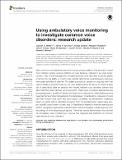| dc.contributor.author | Mehta, Daryush D. | |
| dc.contributor.author | Van Stan, Jarrad H. | |
| dc.contributor.author | Ghassemi, Marzyeh | |
| dc.contributor.author | Guttag, John V. | |
| dc.contributor.author | Cheyne, Harold A. | |
| dc.contributor.author | Hillman, Robert E. | |
| dc.contributor.author | Zanartu, Matias | |
| dc.contributor.author | Espinoza, Victor M. | |
| dc.contributor.author | Cortes, Juan P. | |
| dc.date.accessioned | 2016-01-04T14:14:23Z | |
| dc.date.available | 2016-01-04T14:14:23Z | |
| dc.date.issued | 2015-10 | |
| dc.date.submitted | 2015-06 | |
| dc.identifier.issn | 2296-4185 | |
| dc.identifier.uri | http://hdl.handle.net/1721.1/100569 | |
| dc.description.abstract | Many common voice disorders are chronic or recurring conditions that are likely to result from inefficient and/or abusive patterns of vocal behavior, referred to as vocal hyperfunction. The clinical management of hyperfunctional voice disorders would be greatly enhanced by the ability to monitor and quantify detrimental vocal behaviors during an individual’s activities of daily life. This paper provides an update on ongoing work that uses a miniature accelerometer on the neck surface below the larynx to collect a large set of ambulatory data on patients with hyperfunctional voice disorders (before and after treatment) and matched-control subjects. Three types of analysis approaches are being employed in an effort to identify the best set of measures for differentiating among hyperfunctional and normal patterns of vocal behavior: (1) ambulatory measures of voice use that include vocal dose and voice quality correlates, (2) aerodynamic measures based on glottal airflow estimates extracted from the accelerometer signal using subject-specific vocal system models, and (3) classification based on machine learning and pattern recognition approaches that have been used successfully in analyzing long-term recordings of other physiological signals. Preliminary results demonstrate the potential for ambulatory voice monitoring to improve the diagnosis and treatment of common hyperfunctional voice disorders. | en_US |
| dc.description.sponsorship | Voice Health Institute (National Institute on Deafness and Other Communication Disorders (U.S.) Grant R33 DC011588) | en_US |
| dc.description.sponsorship | Voice Health Institute (National Institute on Deafness and Other Communication Disorders (U.S.) Grant F31 DC014412) | en_US |
| dc.description.sponsorship | MIT International Science and Technology Initiatives | en_US |
| dc.description.sponsorship | Comision Nacional de Investigacion Ciencia y Tecnologia (Chile) (Grant FONDECYT 1151077) | en_US |
| dc.description.sponsorship | Comision Nacional de Investigacion Ciencia y Tecnologia (Chile) (Grant Basal FB0008) | en_US |
| dc.description.sponsorship | Universidad Federico Santa Maria | en_US |
| dc.description.sponsorship | Universidad de Chile | en_US |
| dc.description.sponsorship | Intel Science & Technology Center for Big Data | en_US |
| dc.description.sponsorship | National Library of Medicine (U.S.) (Biomedical Informatics Research Training Grant NIH/NLM 2T15 LM007092-22) | en_US |
| dc.language.iso | en_US | |
| dc.publisher | Frontiers Research Foundation | en_US |
| dc.relation.isversionof | http://dx.doi.org/10.3389/fbioe.2015.00155 | en_US |
| dc.rights | Creative Commons Attribution | en_US |
| dc.rights.uri | http://creativecommons.org/licenses/by/4.0/ | en_US |
| dc.source | Frontiers Research Foundation | en_US |
| dc.title | Using Ambulatory Voice Monitoring to Investigate Common Voice Disorders: Research Update | en_US |
| dc.type | Article | en_US |
| dc.identifier.citation | Mehta, Daryush D., Jarrad H. Van Stan, Matias Zanartu, Marzyeh Ghassemi, John V. Guttag, Víctor M. Espinoza, Juan P. Cortes, Harold A. Cheyne, and Robert E. Hillman. “Using Ambulatory Voice Monitoring to Investigate Common Voice Disorders: Research Update.” Frontiers in Bioengineering and Biotechnology 3 (October 16, 2015). | en_US |
| dc.contributor.department | Massachusetts Institute of Technology. Computer Science and Artificial Intelligence Laboratory | en_US |
| dc.contributor.department | Massachusetts Institute of Technology. Department of Electrical Engineering and Computer Science | en_US |
| dc.contributor.mitauthor | Ghassemi, Marzyeh | en_US |
| dc.contributor.mitauthor | Guttag, John V. | en_US |
| dc.relation.journal | Frontiers in Bioengineering and Biotechnology | en_US |
| dc.eprint.version | Final published version | en_US |
| dc.type.uri | http://purl.org/eprint/type/JournalArticle | en_US |
| eprint.status | http://purl.org/eprint/status/PeerReviewed | en_US |
| dspace.orderedauthors | Mehta, Daryush D.; Van Stan, Jarrad H.; Zanartu, Matias; Ghassemi, Marzyeh; Guttag, John V.; Espinoza, Víctor M.; Cortes, Juan P.; Cheyne, Harold A.; Hillman, Robert E. | en_US |
| dc.identifier.orcid | https://orcid.org/0000-0001-6349-7251 | |
| dc.identifier.orcid | https://orcid.org/0000-0003-0992-0906 | |
| mit.license | OPEN_ACCESS_POLICY | en_US |
